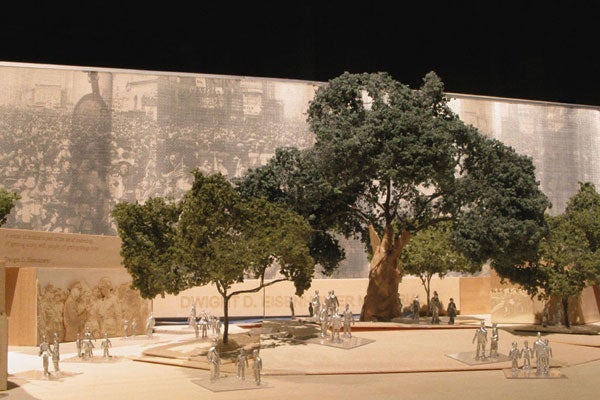This week two more Congressmen, Dan Lungren (R–CA) and Aaron Schock (R–IL), joined the Eisenhower family in opposing Frank Gehry’s design for the Dwight D. Eisenhower memorial, which disrobes a statesman of his legacy and slaps Eisenhower’s name on what is, in fact, a monument to the national experiment in moral relativism.
In art and architecture, postmodern thinking has slowly but steadily stripped public spaces of potential beauty. Now the movement seeks to strip statesmen of their meaning.
Conviction is almost a dirty word in this era of relative truth. But great things are often done or inspired by individuals with convictions. Dwight D. Eisenhower is no exception. The small-town boy turned decorated war commander, U.S. President, and university president was an American statesman. In the journey of his life, the boy from Denison, Texas, grew and matured into a man and discovered a few truths that guided his actions in moments of hardship and decision. It is the man Eisenhower chose to become—despite distraction and adversity—we celebrate.
As Supreme Commander of Allied Forces during World War II, Eisenhower led the struggle to liberate Europe from Nazism. Of that time, he remarked, “Our pleasures were simple—they included survival.” Shortly after WWII, a “Draft Eisenhower” movement catapulted him into national politics and soon into the White House as the 34th President of the United States he fought to defend. Like George Washington, he was the war hero President, beloved by millions of Americans—Republicans and Democrats alike—as well as millions more throughout the world. Eisenhower benefited from growing up in America, the country he loved, but he never ceased to stress the importance of individual character and life-changing decisions: “The history of free men is never really written by chance but by choice; their choice!”
The proposed Eisenhower monument, however, plans to strip him of his moral discovery, his convictions, and his accomplishments. The proposed sculpture—surrounded by towering walls of glass and concrete, adorned with a tangled metal tapestry—depicts him as a barefoot boy. He is reduced to the state of his existence before maturity, before struggle, before the acts that made him deserving of a monument.
Architecture and art not only reveal society’s moral and intellectual state, but they also inform future thought. Gehry’s monument—in the hyper-egalitarian spirit of the French and Russian revolutions—says, “Look here, an average boy like you or me. Let’s celebrate the ambiguous virtue of the common, mass experience, of adolescent ignorance.” The monument’s boy need not be Eisenhower—it could be anyone. So what’s the point?
The point is to hijack the bureaucratic process of planning presidential memorials in order to strip an American statesman of his honor, his manhood, and his acquired wisdom. Future pedestrians need not fear an encounter with heroism. Instead, the future observer of Gehry’s little-boy Eisenhower will stare blankly into the visage of an average, undecided adolescent and feel no judgment, no inspiration, no urge to excel, no call of honor.
Emanating from Gehry’s design is the belief that humans are interchangeable, no one better than the next, regardless of merit, experience, character, or sacrifice. That virtues (honor, valor, public service) are all constructs, and we humans are all basically the same morally. No need to celebrate those who distinguish themselves through acts of bravely in the service of their country.
The ribbon will be cut, the statue unveiled, the monument opened, and the march of the soul-numbing idea goes on: “Why bother?” Gehry’s design is decidedly forward-looking. It is a fateful prophecy of postmodernism’s children: Barefoot boys on concrete, boxed in by glass walls of political correctness that forbid them to inquire after truth and keep them from great thoughts, let alone noble actions.
In time, statesmen will not only become rarer, they will be cut down before they can raise their heads above the rest in an effort to see what the masses refuse to notice. Statesmen preserve the fragile existence of our way of life and the ever-present threats to future liberty—a life and liberty that Eisenhower defended against great odds and with great effort.
According to philosopher and scholar of aestheticism Roger Scruton, architects such as Frank Gehry “have equipped themselves with a store of pretentious gobbledegook with which to explain their genius to those who are otherwise unable to perceive it.” Such structures are “designed to stand out as the work of some inspired artist who does not build for people but sculpts space for his own expressive ends.”
Happily, we do not have to speculate about what Eisenhower would have thought about Gehry’s design; he has already told us. At the dedication of a new Kansas library in 1962, Eisenhower asked the crowd: “Do you think that America has advanced morally as we have materially? When we see our very art forms so changed that we seem to have forgotten the works of Michelangelo and Leonardo da Vinci…is this improvement? What has happened to our concept of beauty and decency and morality?”
Ultimately, architecture critic John Silber lays the blame for public eyesores on those paying for them: “Architecture of the absurd is flourishing thanks to the debasement, inexperience, and supine gullibility of the clients.” The clients of the Eisenhower memorial design are the American people and their representatives in Congress, which funds the Eisenhower Memorial Commission.
Today’s efforts to defend Eisenhower’s legacy from Gehry’s misinterpretation are part of the ongoing fight for the very soul of our society. Congress should reconsider the funding for this aesthetic and moral travesty. More Members of Congress should join the entire Eisenhower family to ensure that President Eisenhower receives a tribute reflecting both his preferences and his monumental contributions to American liberty.




























